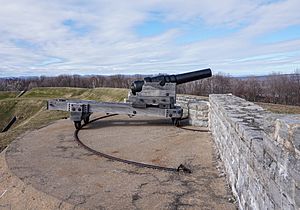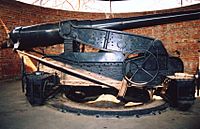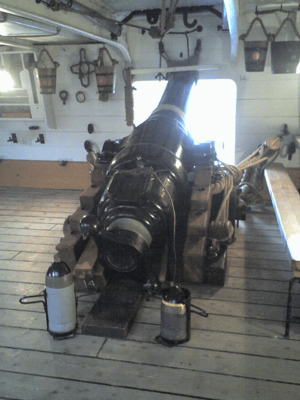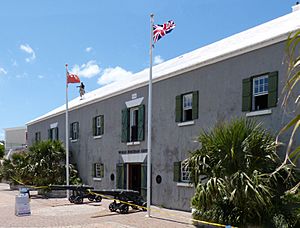Armstrong gun facts for kids
An Armstrong gun was a special type of cannon invented by Sir William Armstrong in England around 1855. These guns were different because they loaded from the back (breech-loading) and had rifling inside the barrel, which made them more accurate. They were built in a unique way, using strong metal tubes and coils to make them very tough.

Contents
The First Armstrong Rifled Guns (1850s-1860s)
In 1854, Sir William Armstrong suggested building a new type of gun for testing. He created a 3-pounder gun that loaded from the back and had grooves inside its barrel (rifling). This gun worked very well, showing great range and accuracy. Over the next three years, he improved his design for even bigger cannons.
The British military officially adopted Armstrong's gun system in 1858. At first, he mainly made smaller cannons. These included 6-pounder guns for mountains or light use, 9-pounder guns for horse artillery, and 12-pounder field guns.
Even though Armstrong thought his system was best for smaller guns, he was asked to make larger ones. These included a 20-pounder for both land and sea, a 40-pounder for sieges, and a huge 110-pounder heavy gun. The Royal Navy used all these guns. Many of them, except the 20-pounder, were also used in New Zealand.
How Armstrong Guns Worked
Armstrong's guns were built in a special way. They had a strong inner tube, called the "A" tube, which held the bore (the inside of the barrel). Around this tube, several strong metal coils were shrunk on. This made the gun very strong and kept the inner tube under pressure.
The inside of the gun barrel had 38 grooves, which is called "polygroove" rifling. These grooves made the shell spin as it left the gun.
The shells were made of cast iron and had a thin lead coating. This coating made the shell fit tightly into the gun's bore and gripped the rifling grooves. This spin, along with the tight fit, helped the gun shoot much farther and more accurately than older, smooth-barreled cannons. It also needed less gunpowder.
An interesting part of the design was a "lubricator" placed on top of each gunpowder cartridge. This lubricator had grease and oil between two tin plates, with a felt pad behind it. As the shell was fired, the lubricator followed it down the barrel. The grease cleaned out any lead left behind by the shell, keeping the barrel clean for the next shot.
Another clever feature was called the "grip." The last 6 inches of the barrel at the muzzle (front end) were slightly narrower. This helped center the shell before it left the gun and slightly squeezed its lead coating. This improved how the shell flew through the air.
Armstrong's breech-loading guns used a special sliding block, called a vent-piece, to close the back of the gun. This block had a copper ring that sealed the firing chamber tightly. A hollow screw behind the block was turned to hold everything firmly in place before firing.
To load and fire the gun:
- The breech screw was loosened.
- The vent-piece was lifted up.
- The shell was put into the gun through the hollow breech-screw and pushed all the way in.
- The gunpowder cartridge was then put into the chamber.
- For larger guns, a primer tube was added to the vent-piece.
- The vent-piece was lowered.
- The breech-screw was tightened to seal the gun.
- A special friction tube with a rope (lanyard) was put into a hole on top of the vent-piece.
- The gunner pulled the lanyard. This ignited a small gunpowder charge in the tube, which then flashed into the main powder chamber, firing the gun.
Armstrong Guns in Battle
British forces used Armstrong guns very effectively in the Second Opium War.
The 12-pounder Armstrong gun was also used a lot in the 1863 conflict in New Zealand between British troops and Maori in the Waikato region. A well-preserved 12-pounder from the battle of Rangiriri can be seen at the Te Awamutu museum. This gun could move its barrel a little to the left or right without moving the whole gun carriage. The army trusted these guns so much that at the Battle of Hairini Ridge, artillery was fired over the heads of their own advancing soldiers as they attacked the ridge.
On July 4, 1868, Armstrong guns were used in Japan at the Battle of Ueno by forces supporting the Imperial government.
Armstrong guns were also used against British and Indian troops during the Second Anglo-Afghan War at the Battle of Charasiab. Six of these guns were captured by British and Indian forces during that battle.
Why They Went Back to Muzzle-Loading Guns
In 1863, a special committee met to compare guns that loaded from the muzzle (front) with those that loaded from the breech (back). In 1864, even before they finished their study, the government stopped making Armstrong breech-loaders.
The committee admitted that Armstrong's guns, though more expensive, were safer. Older cast iron muzzle-loaders often burst, but no Armstrong gun had ever done so. Also, if an Armstrong gun failed to fire, gunners could safely clear it from the breech.

Despite another report that praised the benefits of breech-loaders, the cost was a big factor. The committee finally decided that "The balance of advantages is in favour of muzzle-loading field guns." So, in 1865, Britain switched back from breech-loading cannons to muzzle-loading ones.
Tests in 1859 and 1869 showed that Armstrong's rifled cannons could not break through 4 inches of armor, even from a short distance. This was a big problem because Britain, as a naval power, needed its ship guns to be able to defeat new armored warships being built by other countries.
Armstrong tried to fix the issues with his breech-loaders by developing a new version, but the government had already decided to return to muzzle-loading guns. To allow rifling to be used with muzzle-loaders, Armstrong suggested a new system in 1866. This system used shells with studs on the outside that fit into grooves in the barrel. The government adopted this idea for their first "rifled muzzle-loader" (RML) guns, along with Armstrong's strong built-up construction method.
Later Armstrong Breechloaders

Armstrong started making breech-loading guns again in the 1880s. These newer guns used improved ways to seal the barrel when fired. Armstrong became a major supplier of modern "BL" (breech-loading) guns to the Royal Navy, the British Army, and other countries until the 1920s. However, it's his earlier "RBL" (rifled breech-loading) guns that are usually known as "Armstrong guns."
See Also
- Rifled breech loader
- Disappearing gun for the Armstrong Disappearing Gun.
|





